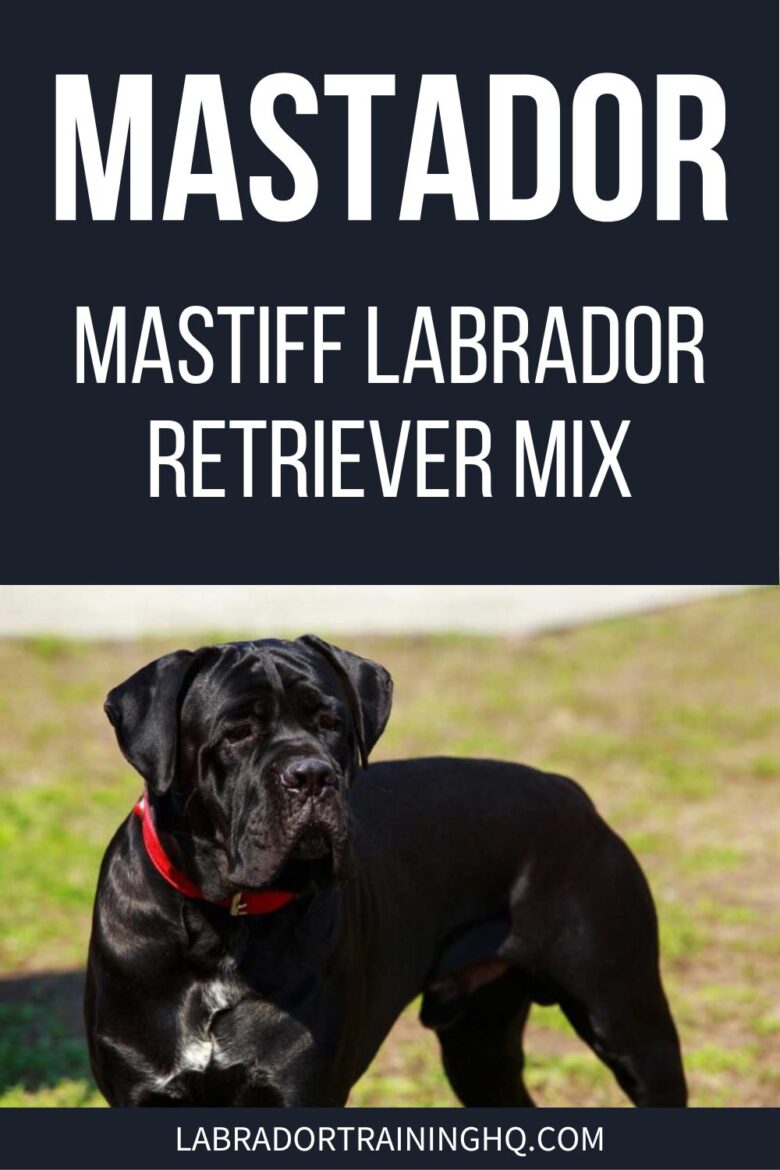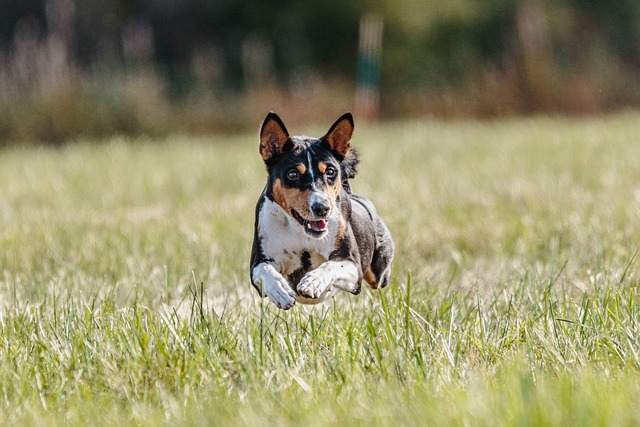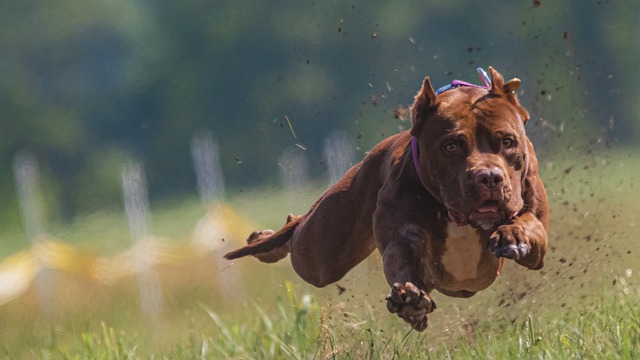Mastador: Mastiff Labrador Retriever Mix
This post may contain affiliate links. We may earn money or products from the companies mentioned in this post.
Are you a fan of giant dogs? The Mastador, or Mastiff Lab mix, might be exactly the dog that you are looking for.
These are intelligent dogs that are extremely friendly and will love to be a member of your family. But they are big! You can expect them to be between 28 and 36 inches tall and weigh 86 to 160 pounds!
Don’t expect your Mastador to be quite as easy to train as a Lab. While they are smart dogs and are very sensitive to you and what you want and need, they get bored easily and won’t tolerate long training sessions.


This is why you won’t see a Mastiff as a disabled help dog, while this is ideal work for a Lab.
Still, with proper socialization and positive reinforcement training rather than punishment, these gentle giants can be loving family pets that can also act as protectors of the home and family without getting aggressive.
Read on for my complete guide on what to expect from a Mastiff Lab mix.
Vital Statistics
- Breed: Labrador retriever and Mastiff mix
- Height: 28 to 36 inches tall
- Weight: 85 to 160 pounds
- Lifespan: 10 to 12 years
- Coat: Short, thick, medium shedding
- Color: Black, brown, yellow, or brindle, solid or mixed
- Intelligence: Highly intelligent but becomes bored easily, very sensitive
- Temperament: Friendly and affectionate
- Exercise Needs: Moderate to high
History Of The Breed
Labrador retrievers are one of the most popular dog breeds in the world both as family pets and as working dogs, especially in disability care.
They were originally bred in England from stock imported from Canada. They were bred to retrieve shot game from both the land and the water.
The term “Mastiff” actually refers to a group of dogs that share similar characteristics that have been around for about 3,000 years.
But when most people talk about Mastiffs, they mean English Mastiffs. These are very large dogs that were used for guarding and hunting.
In more recent times, they have become popular in blood sports due to their size, and even pitted against large wild animals. However, they do not have a naturally aggressive nature.
Mastadors are one of the many designer dog breeds that emerged in the United States in the 1990s with the aim of minimizing some of the health problems associated with pure breeds.
Labrador retrievers are one of the most popular purebred dogs for cross breeding. Most breeders aim to maintain the Lab’s intelligence and friendliness while reducing the amount that these dogs shed!
You can read about various other Lab mixes on the site, including the Weimaraner Lab Mix, Doberman Lab Mix, German Shepherd Lab Mix, Beagle Lab Mix, and more.
Appearance
The most noticeable thing about a Mastador is they are very big dogs. Labradors are already medium to large in size, but Mastiffs are very big dogs that produce big offspring.
You can expect the mother to be a Mastiff and the father to be the smaller Lab for safety while breeding.
Labrador retrievers measure between 21 and 23 inches in height and weigh 55 to 80 pounds. English Mastiffs are much taller and heavier.
The females start from 27.5 inches and can weigh 120 to 170 pounds, while the males start from 30 inches and can weigh as much as 230 pounds.
You can expect their mixed-breed offspring to measure between 28 and 36 inches in height and weigh between 85 and 160 pounds!
Mastadors also have stocky bodies and broad heads, as these characteristics are common to both breeds.
They could have the flat nose of a Mastiff or the longer nose of a Lab, but they will definitely have ears that flop down on either side of their face.
Labradors are known for their short double coats that protect them in the water but also shed a lot. For many people, this is the only complaint they have about Labradors: how much they shed.
Mastiffs, on the other hand, have a short, dense, and silky coat which doesn’t shed quite as much as that of a Lab, but it still sheds.
It can be a bit of a gamble which of these coats your Mastador will inherit, but a shorter, denser coat is more common.
They need to be brushed twice a week to remove loose hair and minimize the issues and irritations associated with shedding.
The variety of colors that exist among the two parent breeds mean Mastadors can look quite different. They can be black, brown, yellow, or brindle, and they may present with a solid color or a mixed coat.
It is fair to say that the size and heads of these dogs make them look pretty imposing and dangerous, but this is not reflected in their personalities.
This is why many breeders and pet owners regard them as gentle giants.
Mastador Parent Breeds’ Temperaments
Labrador retrievers are known for being very intelligent and eager to please, and therefore easy to train. They are also known for being affectionate and friendly, even with smaller animals.
Mastiffs are also intelligent, but they can be a bit lazy and get bored easily. This means they can be difficult to train using traditional methods.
They are also highly sensitive. They are extremely skilled at reading facial expressions and body language and figuring out what is expected of them.
But this sensitivity means they are also more prone to adverse effects when treated badly, for example, trained using punishment.
Mastiffs, like Labradors, are affectionate and love being around people. They get along with other dogs, but they were bred for hunting, so smaller animals around the house can be at risk.
They love kids, but their large size can present potential for accidents. Mastiffs can be aloof and wary around strangers, which is part of the reason why they make good guard dogs.
Mastador Temperament
What does this mix of personality traits mean for the Labrador and Mastiff’s Mastador offspring?
It is not possible to predict the personalities of mixed breed dogs with great accuracy, unlike the case with purebred dogs, but experience can still indicate what to expect.
In general, you can expect a Mastador to be friendly and to love their families. They will want to be part of the family, which means in the house and part of the action, rather than relegated to an outdoor space.
They won’t do well if they are left alone for extended periods while everyone is out of the house. They can easily develop separation anxiety issues.
Mastadors are highly intelligent, but they can easily become bored with long traditional training sessions. After the fifth go, they might just flop down in the ground and give up.
They do best with short training sessions several times a day.
They should never be trained using punishment. This is not a good approach for most dogs, as it tends to lead to confusion rather than teach what is wanted.
But it can be particularly harmful with Mastadors because they are very sensitive. They can become shy, fearful, or aggressive if they are mishandled.
Still, a Mastador will typically be very good at learning from positive reinforcement.
So, as long as you spend lots of time with them in different situations and socialize them extensively with other people and animals, they will figure out what is wanted from them.
Nevertheless, their large size means it is imperative to spend time on the important commands such as “stop” and “sit” so you can get them under control in stressful situations.
They will have a natural desire to protect their people, but this will rarely go beyond posturing.
Nevertheless, you will want to get this under control quickly because it can be scary for people who don’t know your dog is actually a gentle giant.
Exercise Needs
Labrador retrievers are high-energy dogs that need lots of exercise. As adult dogs, they need at least an hour of formal exercise a day, as well as enough space to roam around when at home. And this is a minimum!
However, Mastiffs, despite their large size, can be pretty lazy and don’t need much exercise. They are generally happy with a two-mile walk per day.
They need a lot of space at home, but this is mainly due to their bulk. They need big spaces that they can just flop down in.
They won’t push themselves if they are feeling tired, and they are likely to lay down and refuse to move in the middle of a walk.
Your Mastador pup will be somewhere between the two, but exactly where depends on your individual dog. Monitor them from puppyhood to see what their energy levels are.
Unlike many dogs, these ones will tell you when they are tired, so you aren’t left guessing. Breaking their daily exercise into two shorter sessions is usually the best approach.
Remember that because Mastadors are large dogs, it is easy to over-exercise them as puppies. Pet parents assume that they need to stretch their long legs a lot.
But too much exercise while they are developing can lead to deformities.
While they are puppies, take the approach of five minutes of exercise per day maximum per month of age.
A four-month-old puppy needs about 20 minutes, while at six months they will need 30 minutes a day. Mastadors are still considered puppies until the age of two.
While Labs like to swim, Mastiffs aren’t natural swimmers, and it can be difficult to predict which way a Mastador will lean when it comes to their preference for water.
Take the time to teach your dog how to swim for their own safety, but if they don’t like the water, respect that and don’t force them.
Dietary Needs
Because of their large size, Mastadors need a diet that is specially formulated for larger dogs. This means something that is high in animal-based proteins and fats.
Mastadors can also be prone to skeletal disorders,which means they need the right calcium to phosphorus ratio to develop and maintain their bones.
Look for a ratio of approximately 1.2:1 calcium to phosphorus. This is because calcium can’t build strong bones on its own and needs phosphorus to activate and do the work.
But it is also important to watch how much your dog eats and control their calories, as a Mastador lacks the gene to let them know that they are full. This means that it is easy for them to overeat.
There is no precise science to know exactly how much to feed your dog, and you should always be observing your dog to determine if they are getting what they need to maintain their weight and energy levels.
But, as a general rule, you can determine how much an adult dog should be eating based on their weight.
Multiple their body weight in kilograms raised by ¾ power by 70. For a 10 kilogram dog, that is 70(10) to the power of ¾, which gives you 400 calories.
Puppies need to eat quite a bit more to fuel their growth, so read our full guide to how much to feed a puppy. As they enter their senior years and their metabolism drops, they will need less.
Health Concerns
One of the reasons for creating designer mixed breed dogs is to minimize the hereditary health conditions that are common among purebred dogs due to their limited gene pool.
But while this means that your dog is less likely to inherit health issues from one of their parent breeds, there are more health conditions that should be on your radar “just in case”, as they can inherit traits from either parent.
There are also a few health conditions that are common to both parent breeds and therefore represent a relatively high risk for your dog.
This is not to say that they will definitely develop this kind of problem–it’s just that you and your dog’s vet should monitor your dog for these conditions.
With a Mastador, the main things you should be looking for are skeletal issues, common to many larger breeds.
Elbow and hip dysplasia are both common. Eye issues, including retinal dysplasia and cataracts, are also a common problem.
As well as weight gain, Mastadors can develop gastric dilation volvulus, commonly called bloat. While this doesn’t sound serious, it can be fatal if not treated properly.
This is why you should monitor your dog’s bathroom habits. Dogs are creatures of habit, and you will notice they usually go at around the same time each day with the same frequency and the same quantity.
If this changes, this is often a sign that there is something wrong.
Adopting A Mastador Puppy
Mastadors are actually one of the rarer dogs among the designer breeds that emerged in the 1990s.
This means you can expect it to be relatively difficult to track down a reputable breeder with available puppies.
Don’t expect to pay less than $1,000 for a puppy, since these are expensive dogs to breed just based on the amount of food that mum, dad, and babies consume!
If they are much cheaper than that, you may be dealing with an irresponsible breeder. While you might want to “save” the dog, you shouldn’t, as it will just encourage them to keep breeding.
Also, it is worth looking around for Mastadors in shelters.
While they are wonderful dogs, they are a big responsibility, and many people don’t realize this when they first take one home. Consequently, many end up in rescues and shelters.
You can read our guide to adoption from a shelter vs buying from a breeder here.
FAQs
Is A Mastiff Lab Mix A Good Dog?
Mastiff Lab mix dogs are great because they strike a good balance between friendly and loving and protective without being aggressive.
However, they are also big dogs that need quite a bit of space, and while they don’t tend to enjoy training, they do need to be properly socialized and trained to thrive in urban environments.
How Big Does A Mastiff Mix Get?
Since Mastiffs are such big dogs, you can expect their offspring to be large as well. When mixed with a Labrador retriever, expect them to be 28 to 36 inches tall and weigh 85 to 160 pounds.
Are Mastadors Smart?
Mastadors are extremely intelligent dogs.
But unlike their Lab parents who are eager to learn and please and enjoy work, Mastiffs get bored quickly with traditional training, so it might take a bit longer to teach their Mastador offspring the essential commands.
But Mastadors and their offspring are very sensitive and good at reading body language, facial expressions, and situations. This gives them a good level of independent problem solving skills.
Are Mastiffs Good Inside Dogs?
Despite their large size, Mastiffs are good inside dogs because they are quite lazy and will prefer to spend most of the day hanging about and keeping an eye on what you are up to.
However, it might be more challenging for you to adapt to having such a large presence around if you have a small home.
Should I Bring Home A Mastador?
Are you interested in bringing home a Mastador, but you aren’t sure whether they are the right dog for you?
Ask yourself the following questions to help make your final decision.
Am I Experienced With Dogs?
Mastadors aren’t the best choice for first-time dog owners because they can be tricky to train.
Not only do they get bored with traditional training easily, but they are sensitive, and therefore can easily become traumatized.
If you get upset with them because they are not cooperating, they will sense this, and this can undermine their development.
Mastadors can also be very sensitive to your body language and facial expressions, so it is best that you know how to behave around dogs to control a Mastador and raise them well.
If you aren’t experienced with dogs, you might want to consider something like a Labradoodle.
Do I Have Children Or Other Pets?
While Mastadors love children, they are big dogs, so they can be overwhelming for small children.
If your kids aren’t accustomed to dogs, they can become scared, or they can mishandle the dog that can lead to canine trauma.
Also, their large size means even an accidental whip of the tail could hurt your child.
While Mastadors get on well with other dogs, one of their parents was bred to hunt, so other small household animals, such as cats, can be at risk when a Mastador is around.
If you are looking for a more cat-friendly dog, consider a purebred Labrador retriever.
How Much Space Do I Have?
Even though Mastadors do like to spend quite a bit of time sitting around doing nothing, their big size means that they can quickly make a small apartment feel claustrophobic.
Also, more energetic Mastadors will want to wander around the house monitoring what you are up to.
If you need a smaller Lab mix, consider a Dachsador or a Beagle Lab Mix.
Do I Have An Active Lifestyle?
Mastadors will need quite a bit of exercise, maybe as much as an hour a day. This is something you will need to commit to. Is this compatible with your energy levels and lifestyle?
Do I Spend A Lot Of Time Outside The House?
Mastadors are companion dogs that like to be around their people most of the time. They won’t do well if left at home alone for eight hours while everyone is at work or at school.
They can develop separation anxiety. They do best in homes where there is usually someone around, or if they can accompany someone to work.
Take Home Your Matador
If you decide to adopt a Mastador into your family, you are going to have a loving and loyal member of the family for the next 10 to 12 years.
Make the most of your relationship by spending time with your dog. They are sensitive and will learn a lot from just being around you; plus, there is no place they would rather be.
Finally, to recap, here are this unique mixed breed’s key characteristics again at a glance:
- Breed: Labrador retriever and Mastiff mix
- Height: 28 to 36 inches tall
- Weight: 85 to 160 pounds
- Lifespan: 10 to 12 years
- Coat: Short, thick, medium shedding
- Color: Black, brown, yellow, or brindle, solid or mixed
- Intelligence: Highly intelligent but becomes bored easily, very sensitive
- Temperament: Friendly and affectionate
- Exercise Needs: Moderate to high
Save To Pinterest


Top Picks For Our Dogs
- BEST PUPPY TOY
We Like: Calmeroos Puppy Toy w/ Heartbeat and Heat Packs – Perfect for new puppies. Helps ease anxiety in their new home. - BEST DOG CHEW
We Like: Bones & Chews Bully Sticks – All of our puppies love to bite, nip, and chew. We love using Bully Sticks to help divert these unwanted behaviors. - BEST DOG TREATS
We Like: Crazy Dog Train Me Treats – One of our favorite treats for training our service dog puppies. - BEST FRESH DOG FOOD
We Like: The Farmer’s Dog – A couple months ago we started feeding Raven fresh dog food and she loves it! Get 50% off your first order of The Farmer’s Dog.
For a list of all the supplies we get for our new service dog puppies check out our New Puppy Checklist on the PuppyInTraining.com blog.


